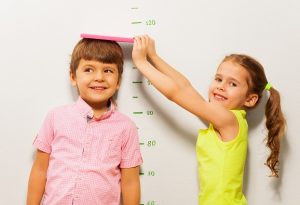Growing Pains and Your Child
Mystery pains are no fun… but if your child is between the ages of 5 and 12, their intermittent pain may not be such a mystery after all. Growing pains are the benign aches children get throughout their limbs at this time of their lives. About 35% of children experience them at some time of their life and they are the most common type of limb pain in juveniles.
Growing Pains Myths 
Despite the name, modern medicine has discovered that these aches and pains are not actually associated with your child’s growing body. The term “growing pains” comes from the 1930s and 40s when people hypothesized that the pain was due to an accelerated growth of the bones that couldn’t keep up with tendon grown. In fact, there is no evidence connecting bone growth to pain. In fact, bones grow very slowly– so slowly that there’s no way it could cause noticeable aches.
It’s also a myth that any old ache your child experiences can be written off as growing pains. Growing pains can be characterized as muscle aches in the legs and arms. The most common areas for pain are the calves and quadriceps (the muscles that make up the front of the thigh). Additionally, they most often occur in the late afternoon or evening and resolve by the morning. Therefore if your child experiences persistent pain throughout the body, it’s time to take them to the doctor for an examination.
So What Causes Them?
If they aren’t caused by growth, what causes growing pains? The answer is not clear at this point in time. Some evidence points to hypermobility or flexibility in children. Other children that report growing pains tend to have very low pain thresholds and often experience abdominal pain and headaches. Some studies point to decreased bone strength in children that experience pain.
The best theory doctors have at the moment is children experience greater amounts of aches and pains after particularly active days. “Overuse” of muscles from jumping, climbing, and running throughout the day leads to fatigue and aches later in the evening. Growing pains may just be a juvenile form of the delayed onset muscle soreness adults experience when beginning a new exercise routine.
Diagnosis of Exclusion
Since doctors do not exactly know what even causes growing pains, it’s not easy to diagnose them. Doctors determine whether or not your child’s aches are growing pains through diagnoses of exclusion. If the doctor does not find another cause for the pain after a thorough examination and your child’s symptoms do not exceed those typically associated with growing pains, they come to this conclusion. If your child experiences fever, limping, persistent pain, swelling, rashes, fatigue, loss of appetite, or a change in behavior, their doctor will want to dig deeper to find the cause of their pains.
Treating Growing Pains
If your child’s doctor establishes their aches as simple growing pains, there are ways to alleviate the discomfort. Lightly massaging their arms and legs relaxes sore muscles and reduces inflammation associated with pain. Teach your child to regularly stretch after exercise to keep muscles limber and reduce achiness. Your child may enjoy yoga as a way to unwind after a day that can also help lengthen and tone their growing muscles.
A warm bath with Epsom salt may help relieve pain and reduce muscle soreness for your child. Though there is little scientific evidence to back this claim, anecdotal evidence is abundant. A heating pad or hot water bottle placed around the area of soreness helps alleviate muscle pain as well. A doctor approved pain reliever can also be administered to help your child’s aching limbs.
Talking to a Pediatric Orthopedic Surgeon
If your child experiences severe, persistent aches and pains, you will want to take them to a Pediatric Orthopedic Surgeon for examination. Before the appointment, identify the answers to the following questions:
- How long are periods of pain?
- What time of day does your child experience the pain?
- Where on the body does your child experience the pain? Is there one concentrated area?
- Does your child wake up at night because of the pain?
- Are there any additional symptoms including swelling, fever, headaches, or abdominal pain?
- Does anything help alleviate the pain?
Your Pediatric Orthopedic Surgeon will examine your child’s bones and muscles to see how he or she responds to touch and movement. Signs of tenderness may signify a deeper issue that necessitates X rays or other tests.
If your child experiences persistent pain in their muscles and joints, contact Dr. Stacie Grossfeld today. Dr. Grossfeld has over 10 years of experience as an Orthopedic Surgeon for both adults and kids alike. As a Pediatric Orthopedic Surgeon, she helps families identify the causes behind abnormal aches and pains in order to find the best treatment. Call 502-212-2663 to make an appointment.

Recent Comments